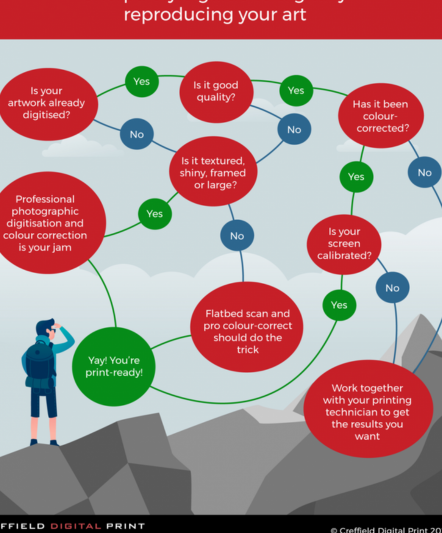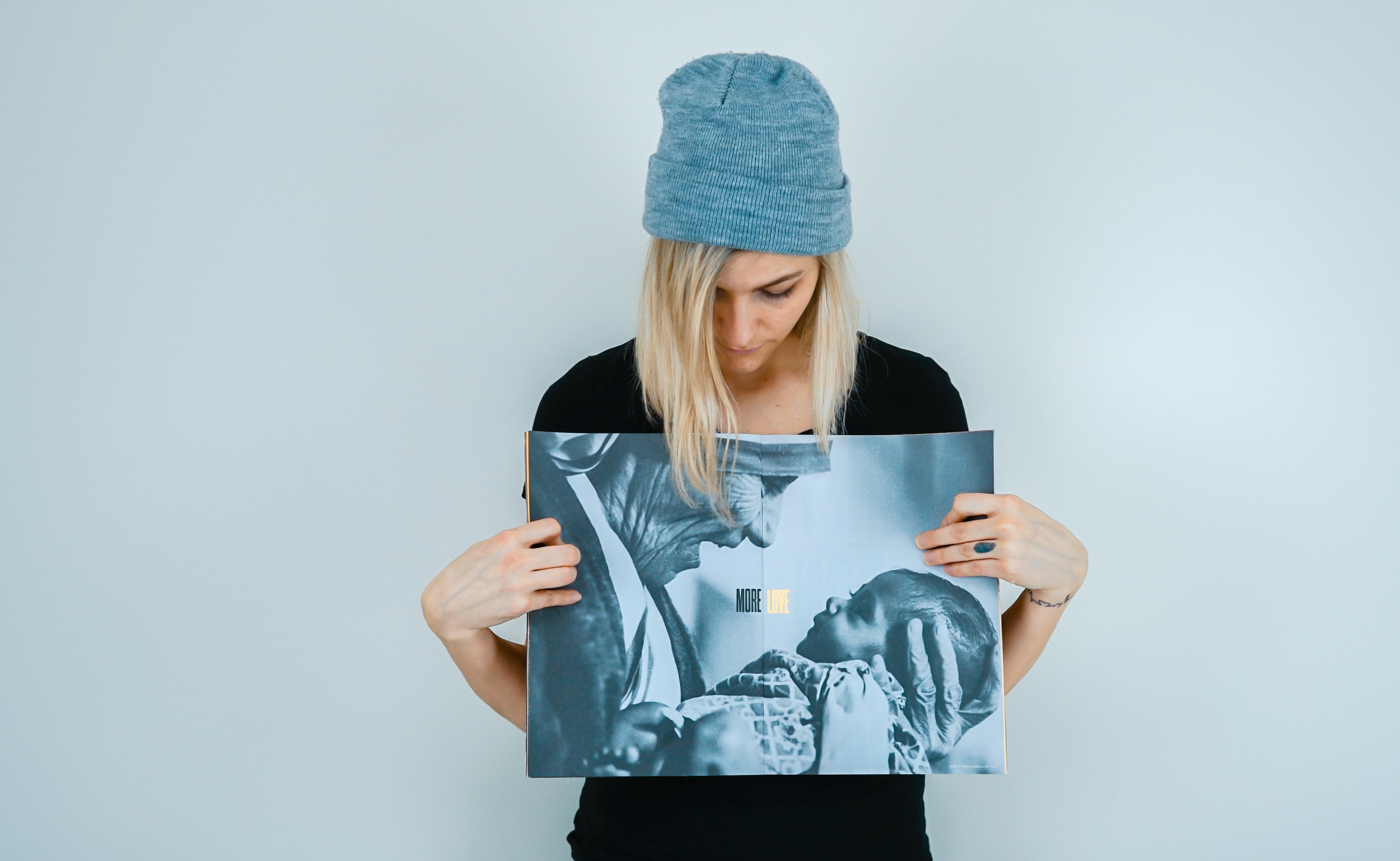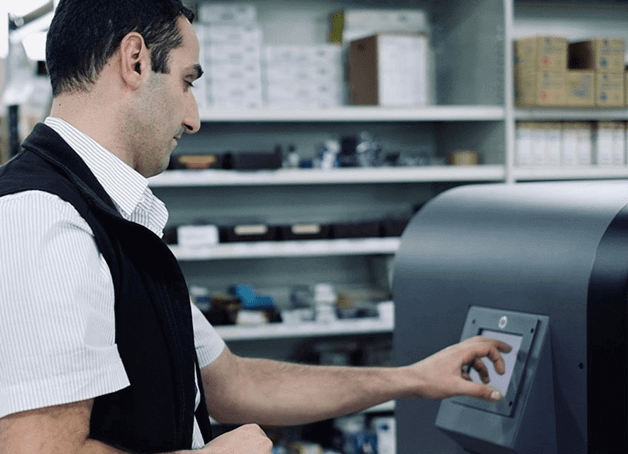A Passion for Providing Quality in Printing
Wooo, so pumped! Let’s do this! Next step: world domination! Errrm ok, hold up there, tiger.. how does one actually go about getting their fine art reproduced? Where do you even start? Is my photo of this artwork good enough? Is it best to scan or photograph it? What about lighting?


You’ve made the decision. Your artwork needs more eyes on it, so you’re taking the plunge with digital reproduction. Good move, grasshopper.
Wooo, so pumped! Let’s do this! Next step: world domination! Errrm ok, hold up there, tiger.. how does one actually go about getting their fine art reproduced? Where do you even start? Is my photo of this artwork good enough? Is it best to scan or photograph it? What about lighting?
Yes, there are specific steps required to digitally reproduce your artwork into a high-resolution master file your artwork, but can you do this yourself -and if not- how do you know if the printer you’re working with is any good?
Whether preparing for an exhibition, honing your style or taking your creative business to the next level, you need to know what to expect from a printing process. For this reason, allow us to be your guides as we embark Sherpa-style on this four-part series; The Artists’ Definitive Guide to Printing where our expedition begins with communication and expectations, and ascends to the dizzying heights of digital reproduction, gamut and colour corrections, printing mediums, ink types and giclée.
There are so many options for fine art printing but finding the right one for your project is the key, and unless you’ve studied extensively or chose the red pill of knowledge, it’s definitely not that easy to achieve on your own.
And, just because a Printing service owns a wide-format ink-jet printer that can print on canvas or art paper doesn’t necessarily qualify them to reproduce your unique work of art. A truly masterful digital reproduction is gained through years of experience in determining the balance of luminescence, contrast, control of colour, sharpness, light and shade.
Nevertheless, when you do find that fine art printing expert who is a perfect match for your artwork, they will not only work with you to create the results you’re after, but also ensure consistency across future orders. Boom. One phone call and orders up!
So. Let’s start with the basics. What should you expect your printer to know? How should they be communicating with you? How can you tell if they are as good as they claim?
We find nothing kills quality like bad communication, so ideally your Printing Service should:
· have been digitally reproducing art for at least five years so you can be confident that they are across the technical kinks involved in reproducing fine art such as capture, colour management, printing and coating
· ask you questions to understand your requirements and expectations prior to undertaking the job and work with you, rather than dictate your end product
· have multiple conversations with you about your print so they can match the best printing options for your work
· offer a choice of materials with different surface textures, weights, composition and base colours
· maintain clear communication and always consult with you after every step
Ok, you’ve reached base camp. Next step, actual image reproduction:
Image capture is by far the most important step in the art reproduction process because it governs how many details, tones and colours will be available in the print file. Unless you have extensive experience with digital reproduction and understand the technical intricacies involved in determining the quality and resolution of your source image, scanning or photographing an original artwork isn’t that simple.
When deciding between scanning and photographing your artwork, the most cost-effective solution is often using a high-quality flatbed scanner. Particularly useful for high-detail mediums such as printmaking or collage that are difficult to translate without the use of a fast macro lens, scanning takes much of the guesswork out of lighting, camera angle and resolution, producing sharp, high quality TIFF files that are ready for colour correction and archival file saving.
For instance, a textured acrylic artwork or oil painting with a shiny surface can end up with glare from the scanner light reflecting off the indentations and textures of the painting and blowing out those elements in the finished digital scan.
Another hurdle to flatbed scanning is if the artwork is currently mounted or framed and whether you have the desire or skill to disassemble and reassemble it. In these cases, photography is your best bet.
Many considerations go into photographing fine art, such as the artistic medium of the piece; texture, surface and colours (e.g. oil vs textured acrylic painting), lighting source, type and strength, camera positioning, file size, filters and lenses used.
For a great digital copy that really picks up the finer details, a professionally lit studio, use of a colour guide and high-quality camera will produce a high-resolution master file ready for high-quality reproduction.
We will go into the finer details of pro-level photographic capture in a future blog, but ultimately, compared to 20-megapixel consumer cameras or even 45-megapixel pro-model cameras, a scanning-back camera captures from 200 to 416 megapixels of data in every image.
I digress. If the concept of megapixels in relation to screen resolution is giving you altitude sickness, lets break it down: in plain English, it simply means that a higher megapixel camera is capable of producing very high-quality DPI images -and if paired with a fast lens- can create prints large enough for billboard-sized reproductions, if that’s your jam!
Of course, if you want to take the guesswork out of the whole process and create truly tour de force reproductions, look no further than your professional Printing Service (see ‘Knowledge and communication’ above to conquer that mountain).
Don’t forget that digital printmaking is not only a collaborative process, but also an extremely creative one which can level you up to new concepts, techniques and innovations and turn your art into something more.
Stay tuned for part 2 of this series, where we’ll do a deep-dive into colour corrections, screen calibrations and colour gamuts: Fine Artists, Photographers and Digital Artists alike will wanna come along for this adventure!
Meanwhile, if you have any further questions about what to expect from a printer and the best way to digitise your own artwork, drop us a line at plots@creffield.com.au or call us on (03) 9329 5177
